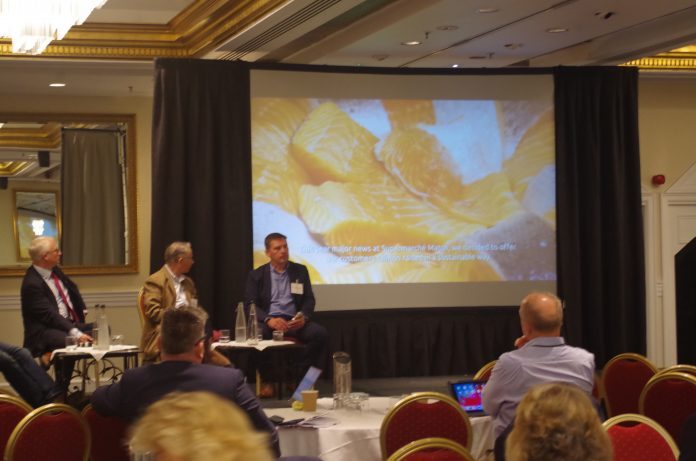Fish veterans discuss the wider benefits of algal oil.
The Millennium Gloucester Hotel, London, was the setting of the third Aquaculture Innovation conference. In a talk discussing entitled “the collaborative adoption of breakthrough innovation” the panel discussed the benefits of Veramaris’ algal oil.
With Veramaris'(whose parent companies are DSM and Evonik) Nebraska facility in full swing, the company’s Global Business Development Director Ian Carr was joined on stage by Youngs’ processing veteran and Fair Seas Limited Director Mike Mitchell as well as Direct Seafoods’ Director of Sustainability Laky Zervudachi.
“What different about Veramaris is that it comes in oil form – which is much easier for feed suppliers to apply – also has a much higher concentration of Omega 3 – which is over 50 per cent concentrated – which contains the DHA and EPA molecule,” said Carr.
Public health and sustainable growth
He added that the two main drivers behind Veramaris were public health and sustainable growth. Carr said that one study in the EU he saw in 2016 attributed 250,000 deaths because of low DHA and EPA.”That’s how important it is,” he said.
“We need to increase the distribution by enriching aquaculture products like salmon – to get it in their diet. But to do that they have to be careful not to increase reliance on the world’s oceans,” said Carr.
Mitchell – who is also Seafish Board Member – said: “This cuts to the heart of the issue. The proposition is “here is something that is a bit better but more expensive”. And I think it speaks that our industry has been production-led for many years – and the farm gate has been the interest of the farmer – how can we grow the fish healthily and quickly while getting the best return?”
Mitchell added: “The salmon farming industry grew from nothing to what it is today. In 1991, I was working for a part of the business called Bluecrest – which was owned by Booker – who owned McConnell salmon. We were a sister company to a salmon grower and working with an integrated supply chain”. He explained that back then he took six of the company’s best cod and haddock processing equipment and made a salmon line. “I remember celebrating the week we did three tonnes. By the time I left Youngs, we were doing 35,000 tonnes of fish every year, the growth was phenomenal – but it meant that production of salmon outstripped the ingredient supply of the feed.”

Weakened
Mitchell explained that the substitution of fish oils for grain oils made sense from a farming point of view but from a consumer point of view it was diluting one of the main reasons a consumer wants to eat oily omega 3 fish, therefore weakening its proposition.
“Veramaris are a biotech company who have looked at our market and they’ve identified a need that speaks directly to our market and the needs of the consumers. This is by giving retailers and foods services a compelling story,” concluded the Young’s veteran.
Restaurants pay extra
Zervudachi- who with Direct Seafoods supplies some of the UK’s most famous venues with fish – added that: “With retailers, you have a small number you need to convince you’ve got a story there. If you are bank contracting your foodservice out to a food caterer – the things you want to do right is to make sure it’s coming from the right resourcing. Some big names have taken this on board as some of the big stories they want to tell while getting the consumer to understand what possibilities are. This is a really positive story that can reboot the industry”.
Novel tech
Carr added we have got to stop thinking about volume and value: “People are prepared to pay more. The price of salmon has doubled but its nutritional value has halved. You have to think about the value creation opportunity here when we start talking about price. The next best alternative is fish oil which is a very established industry, people know how to use it. That ischallenging to compete with on a cost basis on day one. But the cost on the head-on-gutted salmon at the end of the chain is in the region of 2-4 per cent. And most retailers think that is a reasonable trade-off”.

